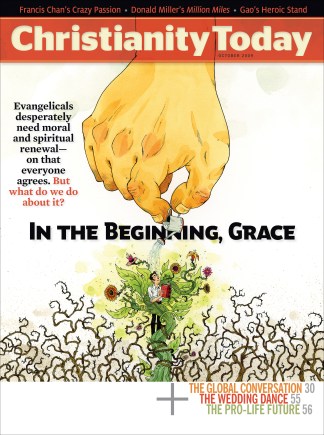It’s you and me, moving at the speed of light into eternity ….” So begins this past summer’s viral YouTube video, “Jill and Kevin’s Wedding Entrance.”
What at first seems like a somber church processional becomes choreographed exuberance, as the couple and their friends shake and boogie down the aisle to Chris Brown’s club hit, “Forever.” Little did Jill and Kevin know that 22,875,767 others would join those in the pews to watch the show.
The video has triggered varied responses from evangelicals. Many have compared the couple’s dancing to King David’s joyful jig, while others have questioned the couple’s silliness upon entering such a serious affair. Others just turned their speakers up and watched again, “because it just makes me feel so darn good!” as one commenter put it. In the midst of this, perhaps it’s time for the church to ask, What is the purpose of the wedding ceremony, anyway?
To answer faithfully, it’s wise to start by forgoing the persistent myth that the wedding ceremony is all about you, the individual that also looms large in contemporary politics and all consumerist rhetoric. Since marriage is at root about two individuals fulfilling their needs and wants, the cultural logic goes, the wedding day is therefore about reflecting those needs and wants. This creed is especially pervasive in Modern Bride and other wedding industry magazines, which remind every young woman that “her day” will be a disaster unless all the details match her wishes. Other couples design the ceremony based on their personalities and shared history, wanting attendees to walk away thinking, “That was so Kevin and Jill.”
By contrast, the Protestant Reformers—and indeed, Scripture—leave little room for any church ceremony not focused on the foundational relationship between God and humans, and, by extension, the human bonds that are essential for a stable, just society. Rejecting the idea that marriage is a sacrament that only clergy can bless, the Reformers saw marriage as a primary social institution God blesses as one gift in his creation (Gen. 2:18).
John Witte, a legal historian who has written much on marriage and family, says the Reformers saw marriage as “a covenantal association of the entire community,” wherein the pastor, families, witnesses, and the couple commit to a contract before God. Like the covenant between Yahweh and the Israelites, the marriage covenant establishes a bond that withstands all the difficulties of human life (“for better, for worse,” and so on). God is present in the covenant bonds and becomes “party, witness, and judge” to the union, writes Witte; leaving out any of the parties is to effectively “omit God from the marriage covenant.”
While no Christian wants to omit God from the wedding guest list, many weddings do so functionally by drawing attention to all the wrong things. More time is devoted to the processional than the vows. Eye-popping amounts of money are spent on details that few will remember a week later. Clothing and music are chosen expressly to stand out rather than to honor and edify those gathered. Vows are made up to reflect the couple’s individuality rather than scriptural wisdom or church teaching on marriage. If Augustine of Hippo was right about finding virtue in properly ordered loves—a hierarchy where God is our supreme love, who rightly orients all our other loves—it seems the Christian wedding has become disarranged.
The key to reordering the Christian wedding is not to strip it of personal touches or references to the marrying couple. A healthy congregation does not erase each member’s identity, but places it in the context of community; likewise, a good wedding ceremony does not ignore the things that make the couple the couple, but puts them in the larger community of those gathered.
Nor is the key to remove all light, celebratory elements because of marriage’s seriousness. This is the beginning of life together, not the end of it. As one commenter said in response to the video, “On our wedding day, we danced with the choir, after the sermon, through the offering, and all through the reception, because dancing means joy and relief that you got to this point.”
As it turns out, the key to a properly ordered wedding ceremony has less to do with us than we think. It begins with the Holy Spirit, giving all parties in the marriage covenant a desire to honor God, admonish and encourage one another, and invite to the big day those who do not know the gospel, allowing the celebration to become a witness to Christ and his Bride and their own wedding day in the new kingdom. Who knows? Maybe there will be dancing there, too.
Copyright © 2009 Christianity Today. Click for reprint information.
Related Elsewhere:
Laura Leonard also wrote about the wedding dance on Her.meneutics, the Christianity Today blog for women.
Previous articles on marriage and love include:
The Case for Early Marriage | Amid our purity pledges and attempts to make chastity hip, we forgot to teach young Christians how to tie the knot. (July 31, 2009)
Does the Bible Really Say All That About Romance? | The Bible pictures God as a passionate, pursuant, and perfect lover. (February 3, 1984)
Sex in the Body of Christ | Chastity is a spiritual discipline for the whole church. (May 13, 2005)










